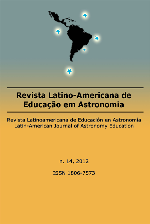TÓPICOS DE FÍSICA SOLAR NO ENSINO MÉDIO: ANÁLISE DE UM CURSO COM ATIVIDADES PRÁTICAS NO OBSERVATÓRIO DIETRICH SCHIEL
Palavras-chave:
Sol, centros de ciências, ensino de astronomia, física solar, ensino de física moderna.Resumo
Este trabalho analisa resultados obtidos em um curso sobre física solar para alunos do ensino médio promovido pelo Observatório Dietrich Schiel da USP. O curso foi elaborado pelos autores com a intenção de investigar concepções sobre o Sol, ensinar tópicos de física moderna relacionados ao Sol e conhecimentos gerais sobre o astro rei. A metodologia de coleta de dados consistiu em gravação em áudio e vídeo das aulas e das entrevistas semi-estruturadas, e respostas a questionários escritos. Os resultados mostraram que a maioria dos participantes concebeu o Sol como constituído por fogo e as manchas solares como buracos na superfície solar. Embora alguns alunos soubessem que um espectro pode ser formado por um prisma ou rede de difração, a maior parte deles desconhecia a natureza das linhas espectrais. Ao longo do curso, este tema foi trabalhado com uma abordagem prática com observação do espectro solar e de lâmpadas e em aulas expositivo-dialogadas. Os resultados obtidos no curso apontam para a importância dos centros de ciências como parceiros da educação formal. Neste caso específico, a Sala Solar do Observatório Dietrich Schiel é um ambiente propício para o ensino de física moderna no ensino médio.
Downloads
Downloads
Publicado
Como Citar
Edição
Seção
Licença
Este é um artigo publicado em acesso aberto (Open Access) sob a licença Creative Commons Attribution, que permite uso, distribuição e reprodução em qualquer meio, sem restrições desde que o trabalho original seja corretamente citado.

